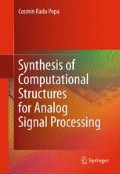Abstract
Exponential circuits represent important building blocks for VLSI signal processing structures, telecommunication applications, medical equipments, hearing aid or disk drives. The exponential function can be obtained in bipolar technology from the exponential characteristic of the bipolar transistor. The nonzero value of the base current and the temperature dependence of the bipolar transistor parameters introduce relatively large errors in the computation of the exponential function. In CMOS technology, the exponential law is available only for the weak inversion operation of the MOS transistor. The great disadvantage of the circuits using MOS transistors in weak inversion is represented by their poor circuit frequency response, caused by the much smaller drain currents available for charging and discharging the parasite capacitances of the MOS transistors. Thus, circuits realized in CMOS technology that require a good frequency response can be designed using exclusively MOS transistors biased in saturation region. Because it exists a relative limited number of mathematical principles that are used for implementing the exponential circuits, the first part of the chapter is dedicated to the analysis of the mathematical relations representing the functional core of the designed circuits. In the second part of the chapter, starting from these elementary principles, there are analyzed and designed concrete exponential circuits, grouped following the mathematical principles they are based on.
Access this chapter
Tax calculation will be finalised at checkout
Purchases are for personal use only
References
Popa C (2004) FGMOST-based temperature-independent Euclidean distance circuit. In: International conference on optimization of electric and electronic equipment, pp 29–32, Brasov, Romania
Manolescu AM, Popa C (2009) Low-voltage low-power improved linearity CMOS active resistor circuits. Springer J Analog Integr Circuits Signal Process 62:373–387
Kao CH, Lin WP, Hsieh CS (2005) Low-voltage low-power current mode exponential circuit. In: IEE proceedings on circuits, devices and systems pp 633–635
Popa C (2003) CMOS current-mode pseudo-exponential circuits with superior-order approximation. In: IEEE-EURASIP workshop on nonlinear signal and image processing, Trieste, Italy (only CD)
Popa C (2004) CMOS current-mode high-precision exponential circuit with improved frequency response. In: International conference on automation, quality & testing, robotics pp 279–284, Cluj, Romania
Popa C (2005) A new current-mode pseudo-exponential circuit with an n-th order approximation. In: The international symposium on system theory, automation, robotics, computers, informatics, electronics and instrumentation pp 404–407, Craiova, Romania
Popa C (2010) Improved linearity CMOS active resistor based on complementary computational circuits. In: IEEE international conference on electronics, circuits, and systems, Athens, pp 455–458, Greece
Landolt O, Vittoz E, Heim P (1992) CMOS selfbiased Euclidean distance computing circuit with high dynamic range. Electron Lett 28:352–354
Lopez-Martin AJ, Carlosena A (1999) Geometric-mean based current-mode CMOS multiplier/divider. In: International symposium on circuits and systems, Orlando, pp 342–345
Kao CH, Tseng CC, Hsieh CS (2005) Low-voltage exponential function converter. In: IEE proceedings on circuits, devices and systems pp 485–487
Jia L, Fengyi H, Xinrong H, Xusheng T (2010) A 1GHz, 68dB CMOS variable gain amplifier with an exponential-function circuit. In: International symposium on signals systems and eElectronics, Nanjing, pp 1–4
Ethier S, Sawan M (2010) Exponential current pulse generation for efficient very high-impedance multisite stimulation. In: IEEE transactions on biomedical circuits and systems pp 1–9
Hedayati H, Bakkaloglu B (2009) A 3GHz wideband ∑Δ fractional-N synthesizer with voltage-mode exponential CP-PFD. In: Radio frequency integrated circuits symposium, Boston, pp 325–328, USA
Moro-Frias D, Sanz-Pascual MT, De La Cruz-Bias CA (2010) Linear-in-dB variable gain amplifier with PWL exponential gain control. In: IEEE international symposium on circuits and systems, Paris, pp 2824–2827, France
Author information
Authors and Affiliations
Corresponding author
Rights and permissions
Copyright information
© 2012 Springer Science+Business Media, LLC
About this chapter
Cite this chapter
Popa, C.R. (2012). Exponential Circuits. In: Synthesis of Computational Structures for Analog Signal Processing. Springer, New York, NY. https://doi.org/10.1007/978-1-4614-0403-3_5
Download citation
DOI: https://doi.org/10.1007/978-1-4614-0403-3_5
Published:
Publisher Name: Springer, New York, NY
Print ISBN: 978-1-4614-0402-6
Online ISBN: 978-1-4614-0403-3
eBook Packages: EngineeringEngineering (R0)

